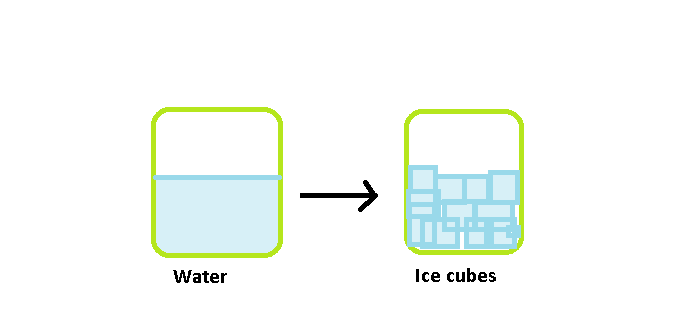温度变化的影响
根据粒子间的力和粒子排列,物质可以被表征为固体、液体或气体。通过改变压力和温度,这三种物质可以相互转化。例如,通过提高冰的温度,它可以从固体转变为液体。条件的变化是指事物的物理变化。它们是可逆变化,不涉及物质化学成分的任何变化。状态转变包括沉积、熔化、升华、冻结、汽化和冷凝。
温度变化对物质的影响
The kinetic energy of matter particles increases as temperature rises, and they begin to vibrate at a higher frequency. As a result, the interparticle force of attraction between particles decreases, and particles become unattached from their positions and free to travel.
结果,物质的状况开始改变。当固体经历相变时形成液体。液体也经过相变变成气体。与温度有关的物质状态变化,即熔化、沸腾等过程如下所述。

温度变化对物质的影响
融化
熔化是一个物理过程,它会导致物质从固体到液体的相变。当固体的内能增加时,通常由于施加热量或压力,物质的温度升高到熔点。熔化是固体转变为液体的过程。熔点是某物熔化的温度。
例如:当冰块从冰箱中取出并恢复到室温时,它们会变成液体。结果,冰块融化并变成了水。

冰融化成水
How does melting occur?
When a solid is heated, it transforms into a liquid. In a solid, the particles gather enough energy to overcome the bonding forces that keep them together. During melting, particles usually begin to move about, keeping close to their neighbours, before moving more freely. The temperature at which this transition takes place in pure substances is known as the melting point of the material.
冷冻
冻结是指液态水转化为固态冰。冻结是一种相变,其中当温度低于其冰点时液体变成固体。液体的凝固相变,通常是由于冷却,被定义为凝固。冰点是液体变成固体的温度。
例如:冰块托盘中的水在冰箱中保存时会凝固。因此,水冷冻机用于制作冰块。

水结冰
How does freezing occur?
When a liquid cools and solidifies, it is called freezing. A solid is formed when the particles in a liquid cease moving around and settle into a stable configuration. This is known as freezing, and it happens at the same temperature as the freezing point.
沸腾
沸腾是液体被加热到沸点时发生的快速蒸发,沸点是液体的蒸气压等于周围大气压力的温度。沸腾是液体物质在快速加热时转变为气体的过程。沸点是某物开始沸腾的温度。
例如: “水的沸腾”是指水在受热时迅速转变为蒸汽或水蒸气。

水沸腾
How does boiling occur?
When particles in a liquid gather enough energy to overcome the bonding forces that hold them loosely together in the liquid, they boil and become free, fast-moving individual particles in a gas. The temperature at which this transition takes place in pure substances is known as the boiling point of the material.
缩合
冷凝是将物质的物理状态从气体变为液体的过程。它与汽化相反。该术语最常用于描述水循环。
例如:装有冷水的玻璃表面存在水滴,是由于空气中的水蒸气与冷水玻璃碰撞时失去能量而凝结成液态。
How does condensation occur?
When a gas is cooled, the particles stop moving around as quickly and become a liquid. Condensation is a process that happens at the same temperature as boiling. As a result, a substance’s boiling point and condensation point are the same temperatures.
升华
升华是物质从固态变为气态而不转变为液态(反之亦然)的过程。升华是用于定义水循环过程的术语,用于描述冰雪在空气中转化为水蒸气而没有首先融化成水的过程。
例如:当干冰(二氧化碳的一种冷冻形式)暴露在空气中时,它会立即从固态转变为气态,以雾的形式可见。
How does sublimation occur?
The change in state occurs when a solid goes directly to a gas called “sublimation” it does not occur at any particular temperature but varies in rate with temperature. For a solid to sublime, individual particles on the surface of the solid obtain enough energy from their surroundings to jump off the surface of the solid and become individual gas particles.
示例问题
问题1:什么是扩散?
回答:
Diffusion is the process of a substance mixing with another substance due to the motion or movement of its particles. It is one of the material’s qualities. The process of one substance diffusing into another continues until a homogeneous mixture is achieved. In gases, liquids, and solids, diffusion occurs.
问题2:什么是蒸发?
回答:
Evaporation is the process of converting a liquid into a vapour (or gas) at its boiling point. In a liquid, certain particles always have greater kinetic energy than others. As a result, the fast-moving particles of a liquid are continually leaving and forming vapour or gas. Evaporation is influenced by temperature, liquid surface area, humidity, and wind speed.
问题3:压力变化对此事有何影响?
回答:
The physical condition of matter can also be altered by varying the pressure applied to it. By exerting pressure and lowering the temperature, gases can be liquefied. A gas is compressed when a high pressure is applied to it, and when the temperature is lowered, it is changed to a liquid. As a result, we may argue that gases can be compressed and cooled into liquids.
问题4:什么是聚变潜热?
回答:
It’s the amount of heat energy needed to turn 1 kilograms of a solid into a liquid at atmospheric pressure and melting point.
问题5:什么是汽化潜热?
回答:
It is the amount of heat energy required to convert 1 kilograms of a liquid into a gas at atmospheric pressure and at the boiling point.